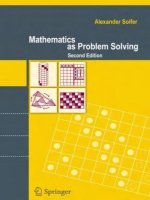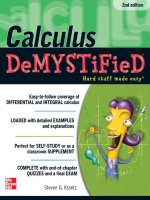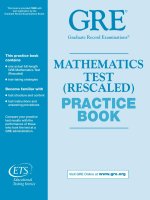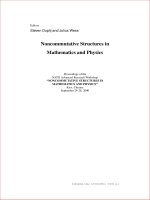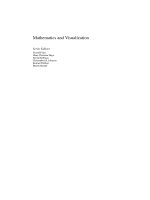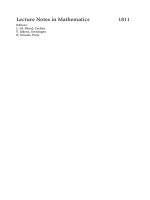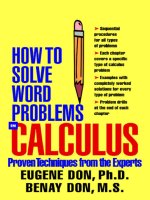mathematics - alder - multivariate calculus
Bạn đang xem bản rút gọn của tài liệu. Xem và tải ngay bản đầy đủ của tài liệu tại đây (1.08 MB, 197 trang )
2C2 Multivariate Calculus
Michael D. Alder
November 13, 2002
2
Contents
1 Introduction 5
2 Optimisation 7
2.1 The Second Derivative Test . . . . . . . . . . . . . . . . . . . 7
3 Constrained Optimisation 15
3.1 Lagrangian Multipliers . . . . . . . . . . . . . . . . . . . . . . 15
4 Fields and Forms 23
4.1 Definitions Galore . . . . . . . . . . . . . . . . . . . . . . . . . 23
4.2 Integrating 1-forms (vector fields) over curves. . . . . . . . . . 30
4.3 Independence of Parametrisation . . . . . . . . . . . . . . . . 34
4.4 Conservative Fields/Exact Forms . . . . . . . . . . . . . . . . 37
4.5 Closed Loops and Conservatism . . . . . . . . . . . . . . . . . 40
5 Green’s Theorem 47
5.1 Motivation . . . . . . . . . . . . . . . . . . . . . . . . . . . . . 47
5.1.1 Functions as transformations . . . . . . . . . . . . . . . 47
5.1.2 Change of Variables in Integration . . . . . . . . . . . 50
5.1.3 Spin Fields . . . . . . . . . . . . . . . . . . . . . . . . 52
5.2 Green’s Theorem (Classical Version) . . . . . . . . . . . . . . 55
3
4 CONTENTS
5.3 Spin fields and Differential 2-forms . . . . . . . . . . . . . . . 58
5.3.1 The Exterior Derivative . . . . . . . . . . . . . . . . . 63
5.3.2 For the Pure Mathematicians. . . . . . . . . . . . . . . 70
5.3.3 Return to the (relatively) mundane. . . . . . . . . . . . 72
5.4 More on Differential Stretching . . . . . . . . . . . . . . . . . 73
5.5 Green’s Theorem Again . . . . . . . . . . . . . . . . . . . . . 87
6 Stokes’ Theorem (Classical and Modern) 97
6.1 Classical . . . . . . . . . . . . . . . . . . . . . . . . . . . . . . 97
6.2 Modern . . . . . . . . . . . . . . . . . . . . . . . . . . . . . . 103
6.3 Divergence . . . . . . . . . . . . . . . . . . . . . . . . . . . . . 116
7 Fourier Theory 123
7.1 Various Kinds of Spaces . . . . . . . . . . . . . . . . . . . . . 123
7.2 Function Spaces . . . . . . . . . . . . . . . . . . . . . . . . . 128
7.3 Applications . . . . . . . . . . . . . . . . . . . . . . . . . . . 132
7.4 Fiddly Things . . . . . . . . . . . . . . . . . . . . . . . . . . 135
7.5 Odd and Even Functions . . . . . . . . . . . . . . . . . . . . 142
7.6 Fourier Series . . . . . . . . . . . . . . . . . . . . . . . . . . . 143
7.7 Differentiation and Integration of Fourier Series . . . . . . . . 150
7.8 Functions of several variables . . . . . . . . . . . . . . . . . . 151
8 Partial Differential Equations 155
8.1 Introduction . . . . . . . . . . . . . . . . . . . . . . . . . . . . 155
8.2 The Diffusion Equation . . . . . . . . . . . . . . . . . . . . . . 159
8.2.1 Intuitive . . . . . . . . . . . . . . . . . . . . . . . . . . 159
8.2.2 Saying it in Algebra . . . . . . . . . . . . . . . . . . . 162
8.3 Laplace’s Equation . . . . . . . . . . . . . . . . . . . . . . . . 165
CONTENTS 5
8.4 The Wave Equation . . . . . . . . . . . . . . . . . . . . . . . . 169
8.5 Schr¨odinger’s Equation . . . . . . . . . . . . . . . . . . . . . . 173
8.6 The Dirichlet Problem for Laplace’s Equation . . . . . . . . . 174
8.7 Laplace on Disks . . . . . . . . . . . . . . . . . . . . . . . . . 181
8.8 Solving the Heat Equation . . . . . . . . . . . . . . . . . . . . 185
8.9 Solving the Wave Equation . . . . . . . . . . . . . . . . . . . . 191
8.10 And in Conclusion . . . . . . . . . . . . . . . . . . . . . . . . 194
6 CONTENTS
Chapter 1
Introduction
It is the nature of things that every syllabus grows. Everyone who teaches
it wants to put his favourite bits in, every client department wants their
precious fragment included.
This syllabus is more stuffed than most. The recipes must be given; the
reasons why they work usually cannot, because there isn’t time. I dislike
this myself because I like understanding things, and usually forget recipes
unless I can see why they work.
I shall try, as far as possible, to indicate by “Proofs by arm-waving” how one
would go ab out understanding why the recipes work, and apologise in ad-
vance to any of you with a taste for real mathematics for the crammed course.
Real mathematicians like understanding things, pretend mathematicians like
knowing tricks. Courses like this one are hard for real mathematicians, easy
for bad ones who can remember any old gibberish whether it makes sense or
not.
I recommend that you go to the Mathematics Computer Lab and do the
following:
Under the Apple icon on the top line select Graphing Calculator and
double click on it.
When it comes up, click on demos and select the full demo.
Sit and watch it for a while.
When bored press the <tab> key to get the next demo. Press <shift><tab>
to go backwards.
7
8 CHAPTER 1. INTRODUCTION
When you get to the graphing in three dimensions of functions with two
variables x and y, click on the example text and press <return/enter>.
This will allow you to edit the functions so you can graph your own.
Try it and see what you get for functions like
z = x
2
+ y
2
case 1
z = x
2
− y
2
case 2
z = xy case 3
z = 4 − x
2
− y
2
case 4
z = xy −x
3
− y
2
+ 4 case 5
If you get a question in a practice class asking you about maxima or minima
or saddle points, nick off to the lab at some convenient time and draw the
picture. It is worth 1000 words. At least.
I also warmly recommend you to run Mathematica or MATLAB and try the
DEMO’s there. They are a lot of fun. You could learn a lot of Mathematics
just by reading the documentation and playing with the examples in either
program.
I don’t recommend this activity because it will make you better and purer
people (though it might.) I recommend it because it is good fun and beats
watching television.
I use the symbol to denote the end of a proof and P < expression >
when P is defined to be < expression >
Chapter 2
Optimisation
2.1 The Se cond Derivative Test
I shall work only with functions
f : R
2
→ R
x
y
f
x
y
[eg. f
x
y
= z = xy −x
5
/5 − y
3
/3 + 4 ]
This has as its graph a surface always, see figure 2.1
Figure 2.1: Graph of a function from R
2
to R
9
10 CHAPTER 2. OPTIMISATION
The first derivative is
∂f
∂x
,
∂f
∂y
a 1 × 2 matrix
which is, at a point
a
b
just a pair of numbers.
[eg. f
x
y
= z = xy −x
5
/5 − y
3
/3 + 4
∂f
∂x
,
∂f
∂y
=
y −x
4
, x − y
2
∂f
∂x
,
∂f
∂y
2
3
= [3 − 16, 2 − 9] = [−13, −7]
This matrix should be thought of as a linear map from R
2
to R:
[−13, −7]
x
y
= −13x − 7y
It is the linear part of an affine map from R
2
to R
z = [−13, −7]
x − 2
y −3
+
(2)(3) −
2
5
5
−
3
3
3
+ 4
↑
(f
2
3)
= −5.4)
This is jus t the two dimensional version of y = mx +c and has graph a plane
which is tangent to f
x
y
= xy−x
5
/5−y
3
/3+4 at the point
x
y
=
2
3
.
So this generalises the familiar case of y = mx + c being tangent to y = f (x)
at a point and m being the derivative at that point, as in figure 2.2.
To find a critical point of this function,that is a maximum, minimum or
saddle point, we want the tangent plane to be horizontal hence:
2.1. THE SECOND DERIVATIVE TEST 11
Figure 2.2: Graph of a function from R to R
Definition 2.1. If f : R
2
→ R is differentiable and
a
b
is a critical point
of f then
∂f
∂x
,
∂f
∂y
a
b
= [0, 0].
Remark 2.1.1. I deal with maps f : R
n
→ R when n = 2, but generalising
to larger n is quite trivial. We would have that f is differentiable at a ∈ R
n
if and only if there is a unique affine (linear plus a shift) map from R
n
to R
tangent to f at a. The linear part of this then has a (row) matrix representing
it
∂f
∂x
1
,
∂f
∂x
2
, ··· ,
∂f
∂x
n
x=a
Remark 2.1.2. We would like to carry the old second derivative test through
from one dimension to two (at least) to distinguish between maxima, min-
ima and saddle points. This remark will make more sense if you play with
the DEMO’s program on the Graphing Calculator and plot the five cases
mentioned in the introduction.
I sure hope you can draw the surfaces x
2
+ y
2
and x
2
−y
2
, because if not you
are DEAD MEAT.
12 CHAPTER 2. OPTIMISATION
Definition 2.2. A quadratic form on R
2
is a function f : R
2
→ R which
is a sum of terms x
p
y
q
where p, q ∈ N (the natural numbers: 0,1,2,3, . . .) and
p + q ≤ 2 and at least one term has p + q = 2.
Definition 2.3. [alternative 1:] A quadratic form on R
2
is a function
f : R
2
→ R
which can be written
f
x
y
= ax
2
+ bxy + cy
2
+ dx + ey + g
for some numbers a,b,c,d,e,g and not all of a,b,c are zero.
Definition 2.4. [alternative 2:] A quadratic form on R
2
is a function
f : R
2
→ R
which can be written
f
x
y
= [x − α, y − β]
a
11
a
12
a
21
a
22
x − α
y −β
+ c
for real numbers α, β, c, a
ij
1 ≤ i, j ≤ 2 and with a
12
= a
21
Remark 2.1.3. You might want to check that all these 3 definitions are
equivalent. Notice that this is just a polynomial function of degree two in
two variables.
Definition 2.5. If f : R
2
→ R is twice differentiable at
x
y
=
a
b
the second derivative is the matrix in the quadratic form
[x − a, y −b]
∂
2
f
∂x
2
∂
2
f
∂x∂y
∂
2
f
∂y∂x
∂
2
f
∂y
2
x − a
y −b
Remark 2.1.4. When the first derivative is ze ro, it is the “best fitting
quadratic” to f at
a
b
, although we need to add in a constant to lift
it up so that it is “more than tangent” to the surface which is the graph of
f at
a
b
. You met this in first semester in Taylor’s theorem for functions
of two variables.
2.1. THE SECOND DERIVATIVE TEST 13
Theorem 2.1. If the determinant of the second derivative is positive at
a
b
for a continuously differentiable function f having first derivative zero at
a
b
, then in a neighbourhood of
a
b
, f has either a maximum or a min-
imum, whereas if the determinant is negative then in a neighbourhood of
a
b
, f is a saddle point. If the determinant is zero, the test is uninforma-
tive.
“Proof” by arm-waving: We have that if the first derivative is zero, the
second derivative at
a
b
of f is the approximating quadratic form from
Taylor’s theorem, so we can work with this (second order) approximation to
f in order to decide what shape (approximately) the graph of f has.
The quadratic approximation is just a symmetric matrix, and all the informa-
tion about the shape of the surface is contained in it. Because it is symmetric,
it can be diagonalised by an orthogonal matrix, (ie we can rotate the surface
until the quadratic form matrix is just
a 0
0 b
We can now rescale the new x and y axes by dividing the x by |a| and the y
by |b|. This won’t change the shape of the surface in any essential way.
This means all quadratic forms are, up to shifting, rotating and stretching
1 0
0 1
or
−1 0
0 −1
or
1 0
0 −1
or
−1 0
0 1
.
ie. x
2
+ y
2
− x
2
− y
2
x
2
− y
2
− x
2
+ y
2
since
[x, y]
1 0
0 1
x
y
= x
2
+ y
2
et cetera. We do not have to actually do the diagonalisation. We simply note
that the determinant in the first two cases is positive and the determinant
is not changed by rotations, nor is the sign of the determinant changed by
scalings.
Proposition 2.1.1. If f : R
2
→ R is a function which has
Df
a
b
=
∂f
∂x
,
∂f
∂y
a
b
14 CHAPTER 2. OPTIMISATION
zero and if
D
2
f
a
b
=
∂
2
f
∂x
2
∂
2
f
∂xy
∂
2
f
∂y∂x
∂
2
f
∂y
2
a
b
is continuous on a neighbourhood of
a
b
and if det D
2
f
a
b
> 0
then if
∂
2
f
∂x
2
a
b
> 0
f has a local minimum at
a
b
and if
∂
2
f
∂x
2
a
b
< 0
f has a local maximum at
a
b
.
“Proof” The trace of a matrix is the sum of the diagonal terms and this is
also unchanged by rotations, and the sign of it is unchanged by scalings. So
again we reduce to the four possible basic quadratic forms
1 0
0 1
x
2
+ y
2
,
−1 0
0 −1
−x
2
− y
2
,
1 0
0 −1
x
2
− y
2
,
−1 0
0 1
−x
2
+ y
2
and the trace distinguishes betweeen the first two, being positive at a min-
imum and negative at a maximum. Since the two diagonal terms have the
same sign we need only look at the sign of the first.
Example 2.1.1. Find and classify all critical points of
f
x
y
= xy −x
4
− y
2
+ 2.
2.1. THE SECOND DERIVATIVE TEST 15
Solution
∂f
∂x
,
∂f
∂y
=
y −4x
3
, x − 2y
at a critical point, this is the zero matrix [0, 0]
so y = 4x
3
and y =
1
2
x
so
1
2
x = 4x
3
⇒ x = 0 or x
2
=
1
8
so x = 0 or x =
1
√
8
or x =
−1
√
8
when y = 0, y =
1
2
√
8
y =
−1
2
√
8
and there are three critical points
0
0
1
√
8
1
2
√
8
−1
√
8
−1
2
√
8
.
D
2
f =
∂
2
f
∂x
2
∂
2
f
∂x∂y
∂
2
f
∂y∂x
∂
2
f
∂y
2
=
−12x
2
1
1 −2
D
2
f
0
0
=
0 1
1 −2
and det = −1 so
0
0
is a saddle point.
D
2
f
1
√
8
1
2
√
8
=
−12
8
1
1 −2
and det = 3 − 1 = 2 so the point is either a
maximum or a minimum.
D
2
f
−1
√
8
−1
2
√
8
is the same. Since the trace is −3
1
2
both are maxima.
Remark 2.1.5. Only a wild optimist would believe I have got this all correct
without making a slip somewhere. So I recommend strongly that you try
checking it on a computer with Mathematica, or by using a graphics calculator
(or the software on the Mac).
16 CHAPTER 2. OPTIMISATION
Chapter 3
Constrained Optimisation
3.1 Lagrangian Multipliers
A function may be given not on R
2
but on some curve in R
2
. (More generally
on some hypersurface is R
n
).
Finding critical points in this case is rather different.
Example 3.1.1. Define f : R
2
→ R by
x
y
x
2
− y
2
.
Find the maxima and minima of f on the unit circle
S
1
=
x
y
∈ R
2
: x
2
+ y
2
= 1
.
Plotting a few points we see f is zero at x = ±y, negative and a minimum
at x = 0y = ±1, positive and a maximum at x = ±1y = 0. Better yet we
use Mathematica and type in:
ParametricPlot3D[{Cos[t],Sin[t],s*Sin[2t]},{t,0,2π},{s,0,1},PlotPoints->50]
It is obvious that Df =
∂f
∂x
,
∂f
∂y
is zero only at the origin - which is not
much help since the origin isn’t on the circle.
Q 3.1.2 How can we solve this problem? (Other than drawing the graph)
17
18 CHAPTER 3. CONSTRAINED OPTIMISATION
Figure 3.1: Graph of x
2
− y
2
over unit circle
3.1. LAGRANGIAN MULTIPLIERS 19
Answer 1 Express the circle parametrically by ’drawing’ the curve
eg
x = cos t
y = sin t
t ∈ [0, 2π)
Then f composed with the map
x
y
: [0, 2π) −→ R
2
t
cos t
sin t
is
f ◦
x
y
(t) = cos
2
t − sin
2
t
= cos 2t
which has maxima at 2t = 0 and 2t = 2π i.e. at t = 0, π and minima at
2t = π, 3π i.e. t = π/2, 3π/2.
It is interesting to observe that the function x
2
− y
2
restricted to the circle
is just cos 2t.
Answer 2 (Lagrange Multipliers)
Observe that if f has a critical point on the circle, then
∇f =
∂f
∂x
∂f
∂y
(= (Df)
T
)
which points in the direction where f is increasing most rapidly, must be
normal to the circle. (Since if there was a component tangent to the circle,
f couldn’t have a critical point there, it would be increasing or decreasing in
their direction.)
Now if g
x
y
= x
2
+ y
2
− 1 we have ∇g
x
y
is normal to the circle from
first semester.
So for f to have a critical point on S
1
, ∇f
x
y
and ∇g
x
y
must be
pointing in the same direction (or maybe the exactly opposite direction), ie
∃λ ∈ R, ∇f
x
y
= λ∇g
x
y
.
20 CHAPTER 3. CONSTRAINED OPTIMISATION
Well, ∇g
x
y
=
∂g
∂x
∂g
∂y
=
2x
2y
and ∇f
x
y
=
∂f
∂x
∂f
∂y
=
2x
−2y
So ∇f
x
y
= λ
∇g
x
y
∃λ ∈ R
⇔
2x
2y
= λ
2x
−2y
∃λ ∈ R
if x = 0, λ = −1 is possible and on the unit circle, x = 0 ⇒ y = ±1 so
0
1
,
0
−1
are two possibilities.
If x = 0 then 2x = 2λx ⇒ λ = 1 whereupon y = −y ⇒ y = 0 and on
S
1
, y = 0 ⇒ x = ±1. So
1
0
−1
0
are the other two.
It is easy to work out which are the maxima and which the minima by
plugging in values.
Remark 3.1.1. The same idea generalises for maps
f : R
n
→ R
and constraints
g
1
: R
n
→ R
g
2
: R
n
→ R
.
.
.
g
n
: R
n
→ R
with the problem:
Find the critical points of f subject to
g
i
(x) = 0 ∀i : 1 ≤ i ≤ k
3.1. LAGRANGIAN MULTIPLIERS 21
We have two ways of pro cee ding: one is to parametise the hypersurface given
by the {g
i
} by finding
M : R
n−k
→ R
n
such that every y ∈ R
n
such that g
i
(y) = 0 for all i comes from some
p ∈ R
n−k
, preferably only one.
Then f ◦M : R
n−k
→ R can have its maxima and minima found as usual by
setting
D(f ◦ M) = [0, 0, . . . , 0
n−k
]
Or we can find ∇f(x) and ∇g
i
(x).
Then:
Proposition 3.1.1. x is a critical point of f restricted to the set
{g
i
(x) = 0; 1 ≤ i ≤ k}
provided ∃ λ
1
, λ
2
, . . . λ
k
∈ R
∇f(x) =
1
i=1,K
λ
i
∇g
i
(x)
“Proof” ∇g
i
(x) is normal to the ith constraint and the hypersurface is
given by k constraints which (we hope) are all independent. If you think of
k tangents at the point x, you can see them as intersecting hyperplanes, the
dimension of the intersection being, therefore, n − k.
∇f cannot have a component along any of the hyperplanes at a critical point,
ie ∇f(x) is in the span of the k normal vectors ∇g
i
(x) : 1 ≤ i ≤ k.
Example 3.1.2. Find the critical points of f
x
y
= x + y
2
subject to the
constraint x
2
+ y
2
= 4.
Solution We have ∇f
x
y
=
∂f
∂x
∂f
∂y
=
1
2y
and
g : R
2
→ R
x
y
x
2
+ y
2
− 4
22 CHAPTER 3. CONSTRAINED OPTIMISATION
Figure 3.2: Graph of x + y
2
has S =
x
y
∈ R
2
: g
x
y
= 0
as the constrained set, with
∇g =
2x
2y
Then ∇f
x
y
= λ∇g
x
y
∃ λ ∈ R
⇒ ∃λ ∈ R,
1
2y
= λ
2x
2y
⇒ λ = 1 and x = 1/2 ⇒ y =
±
15
4
or y = 0 and x = ±2 and λ = ±
1
2
so the critical points are at
1/2
√
15
2
1/2
−
√
15
2
2
0
−2
0
If you think about f
x
y
= x + y
2
you see it is a parabolic trough, as in
figure 3.2.
Looking at the part over the circle x
2
+ y
2
= 4 it looks like figure 3.3. Both
pictures were drawn by Mathematica.
3.1. LAGRANGIAN MULTIPLIERS 23
Figure 3.3: Graph of x + y
2
over unit circle
So a minimum occurs at
x = −2
y = 0
a local minimum at
x = 2
y = 0
and maxima
at
x = 1/4
y =
±
√
15
2
.
24 CHAPTER 3. CONSTRAINED OPTIMISATION
Chapter 4
Fields and Forms
4.1 Definitions Galore
You may have noticed that I have been careful to write vectors in R
n
as
vertical columns
x
1
x
2
.
.
.
x
n
and in particular
x
y
∈ R
2
and not (x, y) ∈ R
2
.
You will have been, I hope, curious to know why. The reason is that I want
to distinguish between elements of two very similar vector spaces, R
2
and
R
2∗
.
Definition 4.1. Dual Space
∀n ∈ Z
+
,
R
n∗
L(R
n
, R)
is the (real) vector space of linear maps fom R
n
to R, under the usual addition
and scaling of functions.
Remark 4.1.1. You need to do some checking of axioms here, which is
soothing and mostly mechanical.
Remark 4.1.2. Recall from Linear Algebra the idea of an isomorphism of
vector spaces. Intuitively, if spaces are isomorphic, they are pretty much the
same space, but the names have been changed to protect the guilty.
25
